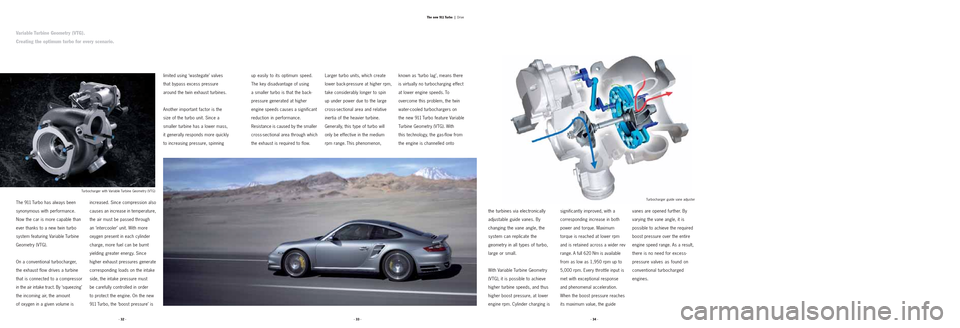tire type PORSCHE 911 TURBO 2004 4.G Information Manual
[x] Cancel search | Manufacturer: PORSCHE, Model Year: 2004, Model line: 911 TURBO, Model: PORSCHE 911 TURBO 2004 4.GPages: 61, PDF Size: 2.14 MB
Page 13 of 61

vanes are opened further. By
varying the vane angle, it is
possible to achieve the required
boost pressure over the entire
engine speed range. As a result,
there is no need for excess-
pressure valves as found on
conventional turbocharged
engines.
· 34 · · 32 ·· 33 ·The new 911 Turbo |
Drive
Variable Turbine Geometry (VTG).
Creating the optimum turbo for every scenario.
known as ‘turbo lag’, means there
is virtually no turbocharging effect
at lower engine speeds. To
overcome this problem, the twin
water-cooled turbochargers on
the new 911 Turbo feature Variable
Turbine Geometry (VTG). With
this technology, the gas-flow from
the engine is channelled onto Larger turbo units, which create
lower back-pressure at higher rpm,
take considerably longer to spin
up under power due to the large
cross-sectional area and relative
inertia of the heavier turbine.
Generally, this type of turbo will
only be effective in the medium
rpm range. This phenomenon,
Turbocharger guide vane adjuster Turbocharger with Variable Turbine Geometry (VTG)
up easily to its optimum speed.
The key disadvantage of using
a smaller turbo is that the back-
pressure generated at higher
engine speeds causes a significant
reduction in performance.
Resistance is caused by the smaller
cross-sectional area through which
the exhaust is required to flow.
The 911 Turbo has always been
synonymous with performance.
Now the car is more capable than
ever thanks to a new twin turbo
system featuring Variable Turbine
Geometry (VTG).
On a conventional turbocharger,
the exhaust flow drives a turbine
that is connected to a compressor
in the air intake tract. By ‘squeezing’
the incoming air, the amount
of oxygen in a given volume isincreased. Since compression also
causes an increase in temperature,
the air must be passed through
an ‘intercooler’ unit. With more
oxygen present in each cylinder
charge, more fuel can be burnt
yielding greater energy. Since
higher exhaust pressures generate
corresponding loads on the intake
side, the intake pressure must
be carefully controlled in order
to protect the engine. On the new
911 Turbo, the ‘boost pressure’ islimited using ‘wastegate’ valves
that bypass excess pressure
around the twin exhaust turbines.
Another important factor is the
size of the turbo unit. Since a
smaller turbine has a lower mass,
it generally responds more quickly
to increasing pressure, spinning
the turbines via electronically
adjustable guide vanes. By
changing the vane angle, the
system can replicate the
geometry in all types of turbo,
large or small.
With Variable Turbine Geometry
(VTG), it is possible to achieve
higher turbine speeds, and thus
higher boost pressure, at lower
engine rpm. Cylinder charging issignificantly improved, with a
corresponding increase in both
power and torque. Maximum
torque is reached at lower rpm
and is retained across a wider rev
range. A full 620 Nm is available
from as low as 1,950 rpm up to
5,000 rpm. Every throttle input is
met with exceptional response
and phenomenal acceleration.
When the boost pressure reaches
its maximum value, the guide